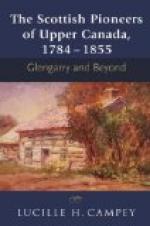[Footnote 3: On the shores of these islands they noticed “several great beasts like oxen, which have two tusks in the mouth similar to those of the elephant”. These were walruses.]
Later on he coasted New Brunswick, and paused for a time over Chaleur Bay, hoping it might be the opening to the strait across the continent of which he was in search; but finding it was not, he continued northwards till he had almost rounded the Gaspe Peninsula, a course which would have led him straight away into the wonderful discovery of the St. Lawrence River, but that, being forced by bad weather into Gaspe Bay, and perhaps hindered by fog, instead of entering the St. Lawrence he sailed right across to Anticosti Island. After that, being baffled by bad weather and doubtful as to his resources lasting out, he decided to return to France through the Strait of Belle Isle.
So far he had failed to realize two of the most important things in the geography of this region: the broad southern entrance into the Gulf of St. Lawrence (subsequently called Cabot Strait), which separates Newfoundland on the north from Cape Breton Island on the south, and the broad entrance into the River St. Lawrence between Anticosti Island and the Gaspe Peninsula.
Yet, whilst staying in Gaspe Bay, he had a very important meeting with Amerindian natives of the Huron-Iroquois stock, who had come down the River St. Lawrence from the neighbourhood of Quebec, fishing for mackerel. These bold, friendly people welcomed the French heartily, greeting them with songs and dances. But when they saw Cartier erect a great cross on the land at the entrance to Gaspe Bay (a cross bearing a shield with the arms of France and the letters “Vive le Roi de France"), they were ill at ease. It is certain that not one word could be understood in language between the two parties, for there were as yet no interpreters; but the Amerindians were probably shrewd enough to perceive that Cartier was making some claim on the land, and they explained by signs that they considered all this country belonged to themselves. Nevertheless, Cartier persuaded two youths, the sons of one of the chiefs, to go back with him to France on his ship, to learn the French language, to see what France looked like, and to return afterwards as interpreters. The boys, though they were practically kidnapped at first, were soon reconciled to going, especially when they were dressed in French clothes!
[Illustration: JACQUES CARTIER]
When Cartier was on his way home he sailed in a north-easterly direction in such a way as to overlook the broad channel between the Gaspe Peninsula and Anticosti Island, but having rounded the easternmost extremity of that large island, he coasted along its northern shores until he caught sight of the opening of the Canadian channel to the west. He believed then that he had discovered the long-looked-for opening of the trans-continental passage, and sailed for France with his wonderful news.




